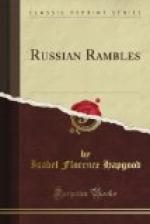If I were a nun I should prefer activity. I think that contemplation, except in small doses, is calculated to produce stupidity. Illustration: I was passing along a street in Moscow when my eye fell upon an elderly nun seated at the gate of a convent, with a little table whereon stood a lighted taper. Beside the taper, on a threadbare piece of black velvet, decorated with the customary cross in gold braid, lay a few copper coins before a dark and ancient ikona. Evidently, the public was solicited to contribute in the name of the saint there portrayed, though I could not recollect that the day was devoted to a saint of sufficient importance to warrant the intrusion of that table on the narrow sidewalk. I halted and asked the nun what day it was, and who was the saint depicted in the image. She said she did not know. This seemed incredible, and I persisted in my inquiry. She called a policeman from the middle of the street, where he was regulating traffic as usual, and asked him about the ikona and the day, with the air of a helpless child. Church and State set to work guessing with great heartiness and good-will, but so awkwardly that it was the easiest thing in the world for me to refute each successive guess. When we tired of that, I gave the nun a kopek for the entertainment she had unconsciously afforded, and thanked the policeman, after which the policeman and I left the good nun sitting stolidly at the receipt of custom.
Quite at the opposite pole was my experience one hot summer day in the Cathedral of the Assumption, where the emperors have been crowned for centuries; or, to speak more accurately, the two poles met and embraced in that church, the heart of the heart of Holy Russia. The early Patriarchs and Metropolitans are buried in this cathedral in superb silver-gilt coffins. Of these, the tomb and shrine of Metropolitan Jona seems to be the goal of the most numerous pilgrimages. I stood near it, in the rear corner of the church, one Sunday morning, while mass was in progress. An unbroken stream of people, probably all of them pilgrims to the Holy City, her saints and shrines, passed me, crossed themselves, knelt in a “ground reverence,” kissed the saint’s coffin, then the hand of the priest, who stood by to preserve order and bless each person as he or she turned away. To my surprise, I heard many of them inquire the name of the shrine’s occupant after they had finished their prayers. After the service and a little chat with this priest, who seemed a very sensible man, we went forward to take another look at the Vladimir Virgin, the most famous and historical in all Russia, in her golden case. A gray-haired old army colonel, who wore the Vladimir cross, perceiving from our speech that we were foreigners, politely began to explain to us the noteworthy points about the church and the Virgin. It soon appeared, however, that we were far more familiar with them all than he was, and we fell into conversation.




